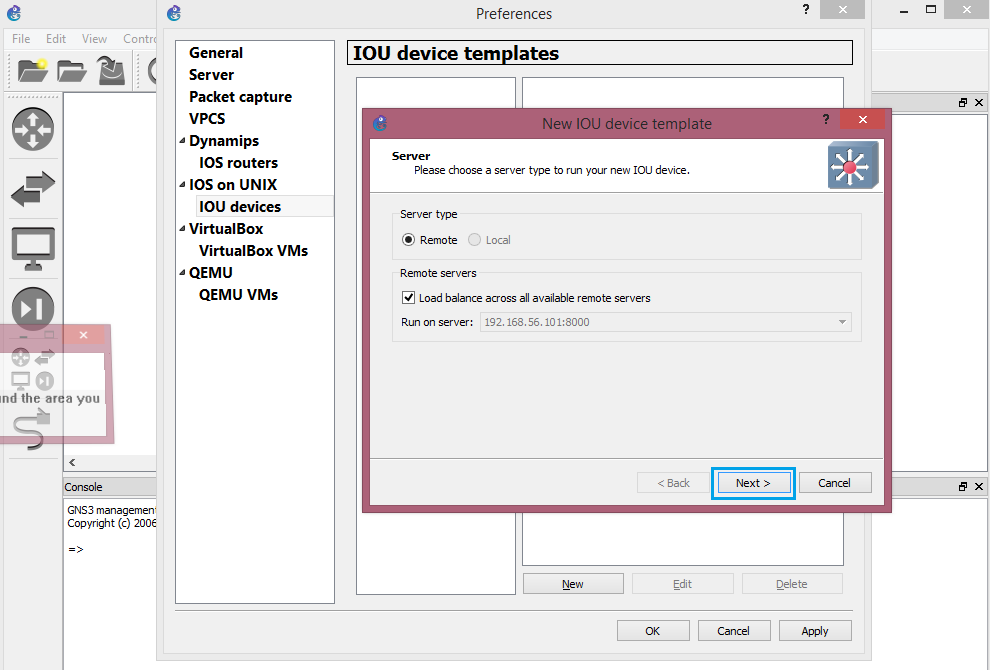
- #Gns3 host binding install#
- #Gns3 host binding update#
- #Gns3 host binding upgrade#
- #Gns3 host binding software#
- #Gns3 host binding code#
Now, we are only running the local server. The server summary shows all the servers you are running. The topology summary shows all the network devices you are currently running and whether they are on or off. The other essential panels are the Topology summary, Servers summary, and console. GNS3 GUI Window – Appliances panelĪt the top of the window, we have the menu bar and a toolbar with additional features like Create notes, Drawing tools, Start/Stop appliances, Zoom in/out, and many more. These include routers, Virtual PC’s (VPCs), Switches, cables, etc. It is where we select the different network devices we want to use. On the left side of the window, we have the GNS3 appliances toolbar. The GNS3 window comes with tonnes of features and tools you need to simulate a network. GNS3 GUI Window GNS3-GUI Features and Tools GNS3 – Local Server Configurations summaryĬlick Finish. You will see a window displaying the set configurations. If the configuration completed successfully, a window will pop-up displaying the local server status. When you are done applying these configurations, click Next. Port = 3080 GNS3 – Local Server Configurations Now configure the local server settings: the server path, Host Binding, and the port. GNS3 – Choose where to run your appliances We will pick the option “run appliances on my local computer.” Click Next. For this post, since we are using Ubuntu, we don’t need the GNS3 VM to run IOS/KVM devices. The first one is where you want to run your network simulations-either the GNS3 VM or your local server.

If you are running GNS3 for the first time on your computer, there are a few configurations that you will be required to set. When the installation completes successfully, we should be able to launch GNS3 from the application menu. GNS3 Installation – Configuring Wireshark Starting GNS3 – GUI Since this might be a security risk, choose No. Step 7) Another window will open, asking you whether non-super users should be able to capture packets. Step 6) A pop-up window will open asking you whether non-super users can run GNS3, highlight Yes using the tab key, and press enter.
#Gns3 host binding install#
sudo apt-get install gns3-gui Install GNS3-GUI application
#Gns3 host binding update#
sudo apt-get update Update System Packages Step 4) Update the system to add the required packages for the GNS3 installation. sudo add-apt-repository ppa:gns3/ppa Adding the GNS3 PPA repository
#Gns3 host binding upgrade#
Step 2) Perform an upgrade to ensure you have the latest packages installed. Step 1) Update your system packages by running the command below. We will download GNS3 using the apt repository. All our network devices will run on our local server. Therefore, we will not require a GNS3 VM. Since we are running GNS3 on Ubuntu, we shouldn’t worry about the support of IOS/IOU/KVM images. If you are not using a GNS3 VM or GNS3 server, the devices will run on your local OS commonly put as the local server. In such a situation, a remote server would be of great help. At times, you might need to create an intricate network that will consume your laptop’s memory. The GNS3 Server runs your devices on a remote machine saving your PC resources. Therefore, if you are running GNS3 GUI version 2.2.3 and you want to use GNS3 VM, then it should also be version 2.2.3. Also, the GNS3 GUI application version should be the same as the GNS3 VM version for you to configure them correctly. It runs on the VMware virtualization software. The GNS3 VM is a utility mainly for Windows and OSX users who want to run IOS/IOU/KVM images.

It’s a graphical user interface with several devices to simulate a network.

We will create or network topologies and labs on the GNS3 application. Therefore, before getting down to the download and installation process, let’s look at some of the components we will need – GNS3 application and GNS3 VM or GNS3 Server.
#Gns3 host binding software#
Getting started with GNS3ĭespite being one of the best network simulation software in the market, GNS3 comes with several complexities. It has opened a whole new world in the field of networking – Network Automation using Python and Ansible scripts. GNS3 version 2.0 and newer releases support the Docker feature. These include CISCO, Juniper, Aruba, Cumulus, Arista, and many more. GNS3 is also a multi-vendor support application enabling you to create labs using devices from several vendors.
#Gns3 host binding code#
It is open-source software, and so you can find the complete source code in GitHub. Having grasped that, we can now look at other exciting features of GNS3.

When you use a router in GNS3, you are running the real device operating system. A Network Simulator, on the other hand, is software that virtualizes your hardware enabling it to support the operating system of different networking devices.


 0 kommentar(er)
0 kommentar(er)
